




|
Home |
|
Classes |
|
Syllabus / Styles |
|
Biography |
|
Poetry |
|
Photos |
|
Articles |
|
Labyrinths |
|
Storytelling |
|
Artwork |
|
Respects Due |
|
Contact |
|
Links |


|
...with a spirit of self-exploration |

|
Pennine Tai Chi |



|
Of Snakes, Cranes and Chang San-feng |
|
The story of Chang San-feng is probably familiar to virtually all Tai Chi practitioners. Some like to think of this as a true account of the origins of Tai Chi, whereas others consider it merely to be a fanciful tale, and prefer to stick to what verifiable historical facts can be ascertained. Either way - as with most legends - there are perhaps more layers of meaning than at first meet the eye. I would like to reassess the story and offer an interpretation on a symbolic level. First let us look at the traditional telling. |
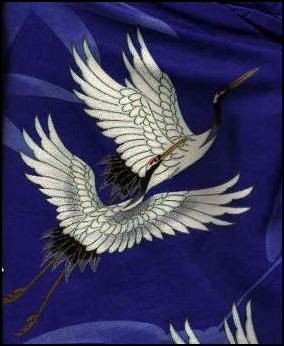
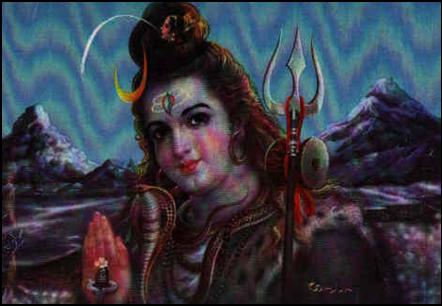
|
The Crane in the Art of MovementIn the martial arts there is the system of White Crane Kung Fu which acknowledges Tibetan connections in its origins and is said to have been taken to China by travelling priests / monks. This style uses fast, fluid and dynamic movements in which the arms swing like giant wings and a beak shaped hand is used to make pecking strikes. Flying Crane Qigong is another sophisticated and graceful system for health and energy cultivation, whilst we have already mentioned crane movements within Tai Chi.
The SnakeIn Pagan cultures the snake is often connected with female deities and the Earth Mother. Minoan statues of the Mother Goddess show her holding snakes in her hands, the Great Goddess Ishtar from Babylonia is often portrayed with a serpent, and Athena the Greek Goddess of Wisdom and War revered the snake. The Celts associated snakes with healing waters and wells. |
|
In Christianity the snake is associated with Satan – the Tempter, the Garden of Eden, Eve, evil and the dark forces of mankind. When related to the Tree of Knowledge it is seen as malevolent, connected with Lucifer and the Fall. When related with the Tree of Life it is considered to be benevolent, connected with Christ and the Salvation. The symbol of a snake crucified on a cross represents the death of the ‘lower passions’. In Hinduism the snake is the guardian of the door threshold and of treasures (both material and spiritual). The kundalini serpent represents energy coiled at the bottom of the spine (the seat of cosmic energy) and the interplay of the two intertwined snakes of ida and pingala (yin and yang) create energy in all its manifestations. The snake’s lidless eyes are seen as a representation of watchfulness and wisdom. Notice the connection here with Bodhidharma who during his 9 years of meditation within a cave removed his eyelids so that he could keep constantly aware. The Caduceus Staff – The Rod of the Healer and the Messenger |
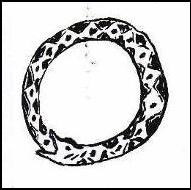
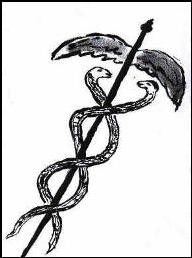
|
The Indian image of intertwined serpents bears striking resemblance to the western symbol of the staff of Hermes / Mercury. The story says that Hermes used his staff to separate 2 serpents that were locked in combat, and consequently the Caduceus is seen as a symbol of peace and healing. The snakes represent opposites or dualism, such as good and evil, knowledge and blind passion, healing and poison, death and rebirth. The staff represents the balancing factor, the central path and axis. |
|
The Ouroborus –The Tail DevourerThe serpent with its tail in its own mouth is a symbol of eternity, the round of existence, cycles of change, death and rebirth. It eternally consumes and renews itself giving rise to the saying ‘my end is my beginning’. In China the snake is one of the animals of the Chinese zodiac. It shares many similarities with the dragon, which is sometimes known as the snake with legs. Manoeuvring across the ground on their bellies means that they are intimately linked with yin energy and the EARTH, whilst their aquatic abilities also connects them with the yin natured element of WATER. |
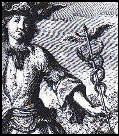
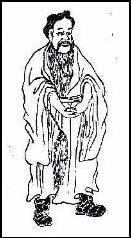
|
Chang the HermitLegend tells us that the founding father of Tai Chi lived around the late 13th century and early 14th century. He left his position as a government official to live the life of a wanderer and a hermit in the mountains. Travelling from place to place he learnt techniques of meditation and martial arts under various Taoists. Until this time, most martial arts systems used great force, effort and muscular strength. Chang San-feng was dissatisfied with how these systems related to the principles and philosophies of his Taoist practices. One day, he was witness to a snake and a crane in combat with each other. He watched as the crane swooped down from a tree with its wings fully spread, the snake hissed a challenge which the crane took up by using its sharp pointed beak to initiate an attack. The snake used its deceptive coiling movements to evade the danger and responded by lashing at the crane with its tail. The crane lifted its leg to avoid the strike and then used its claws to attack. Again the snake evaded this by twisting and turning, whilst instinctively countering with its mouth. The crane curled its neck to escape the venom and beat its huge wings to force the snake away. |
|
Eventually, after tiring themselves out, the two combatants called a draw, the snake slithered away and the crane returned to its tree perch. Mesmerised and exhilarated by this contest – Chang realised that he had been witnessing a perfect exhibition of the I Ching principles of adapting to change and the ability to blend soft and hard, strength and yielding. The continuity and flow of the circular movements seemed in accord with his Taoist observations of nature. He studied the crane and the snake as well as other wild animals, the movement of water, winds and clouds, the nature of bamboo and trees. These natural movements and feelings were gradually embraced and incorporated into his new system. Chang San-feng lived in the Wu Tang Mountains and it was here that he taught several disciples. Today we see remnants of this story in the Tai Chi movements of ‘White Crane Spreading its Wings’ and in ‘Snake Creeps Down’. The crane and the snake are two creatures that are rich in symbolism. Before considering their dual significance within the context of this story, we should look at each of them individually.
The CraneIn China the crane is seen as symbolising longevity, immortality, happiness and good fortune. It is considered to be a Messenger of the Gods and an intermediary between Heaven and Earth. As such, it represents higher states of consciousness and the ability to travel to other worlds. Pure white cranes are said to inhabit the Isles of the Blessed and to carry the souls of immortals and others to the Western Paradise. This explains the ancient Chinese practice of placing figures of cranes on coffins. Their role in the communion between heaven and earth is reflected in western folklore, where a long told tale to children is that they were brought to this world by a stork, and it is still common for storks to be depicted on congratulation cards. The crane’s connection with the soul is echoed in another closely related bird, the swan. In the Greek tradition, a Pythagorean fable is that the souls of all good poets turn into swans. The Hindi language has the same word for ‘soul’ and ‘swan’ – the bird that laid the cosmic egg, giving birth to Brahma (the Creator). In Greek folk dance, the Crane Dance is said to have its origins when Theseus was returning to Greece with Ariadne, after slaying the Minotaur. They stopped for the night on the island of Delos and performed the Crane Dance in celebration. As this is also a mating dance, it may also be the story’s way of saying that their relationship was consummated. The crane’s white feathers are seen as a symbol of purity and relate to the AIR element and the yang of the heavens. Their red head feathers are considered to be a sign of vitality and connect to the yang element of FIRE. |
|
Cranes in flight—detail from silk gown |
|
Shiva entwined by a snake carries his trident and drum. In his right hand is a female yoni penetrated by a male lingum giving birth to the flowering of life. From his head, his female aspect Shakti gives out a stream of water - the nourisher of life |
|
The Snake in the Art of MovementIn the Chinese martial arts there is the system of Shequan (Snake Shadow Boxing). This style utilises twisting and coiling movements to evade attacks; one hand is cupped like a snake’s head and finger strikes mimic the snakes forked tongue. The snake is one of the 8 animals of Pa-Kua, one of the 12 animals of H’sing-I, and one of the 8 animals of the Indian martial art of Kalarippayyatu. Within Tai Chi, we see the movement ‘Snake Creeps Down into the Water’ followed by ‘Golden Cock Stands on One Leg’. Gerda Geddes translates this symbolically as the snake of knowledge descending into the waters of wisdom to arise transformed as a golden cock. The rooster rises with the sun and heralds a new day and so represents rebirth and new beginnings. Chang San-feng RevisitedWise to some of the symbolism, we can perhaps return to the Tai Chi origin story and look at some of its deeper levels of meaning. It turns out that the image of a snake and bird in combat is quite a regular occurrence in myths from around the world. Whereas in China it may be the crane and the snake, in the West it is usually the eagle and the snake, to Native Americans it is the Thunderbird and the snake, in India it is the Garuda bird and the Naga snake. The snake represents the earthbound, our physical and instinctive impulses, and living underground, it is considered to be in touch with the underworld (it is sometimes called ‘the master of the bowels of the earth’). By contrast, the crane, which soars into the skies, is in touch with the heavens and is analogous with the spiritual. The place where they both meet and interact is the earth. On one level, the Chang San-feng story is a pictorial analogy of the Taoist notion of humanity aiming to bring about a balance within ourselves between the yang energies of the heavens and the yin energies of the earth. This battle of the material and the spiritual, intellect and instinct, higher and lower nature, is an age-old battle that many philosophies and religions try to reconcile.
To Harm or to HealThe development of Tai Chi Chuan has been the coming together of two apparently contradictory areas. On the one hand, it has roots in the martial arts, which can be seen as its earthly nature, the need for survival and physical security. On the other hand, many of its practices are rooted in meditation and the healing arts. This adds the spiritual element to the formula. To do Tai Chi can therefore be seen as a physical manifestation of this interplay of opposites. It aims towards a dynamic balance; whilst at the same time acknowledging that both are necessary and ultimately inseparable (being aspects of the same). The practice encourages us to be constantly open to and sensitive to this ever-changing game (of rise & fall, open & close, advance & retreat, contract & expand, life & death, creation & destruction). Perhaps in few other areas is the paradoxical ability to harm or to heal so apparent. Use it well!
Bibliography The History and Philosophy of Kung Fu by E. C. Medeiros An Illustrated Encyclopedia of Traditional Symbols by J. C. Cooper Looking for the Golden Needle by G. Geddes Katha Upanishad translated by Swami Ambikananda Saraswati |
Snakes and Ladders – The Game of KnowledgeThe snakes and ladders board game has its roots in the ‘game of knowledge’, most likely originating from India. The aim of the game is to ascend towards the highest states and avoid the hells at the bottom. The ladders represent good conduct and knowledge, while the snakes stand for ignorance and evil. |
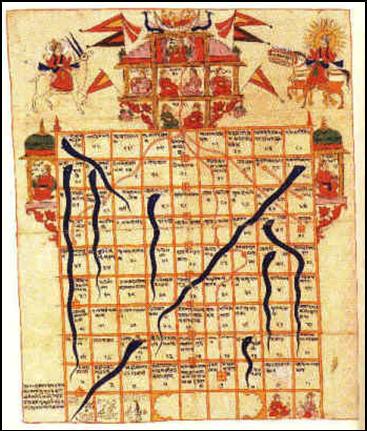
|
The Game of Life from Rajasthan 19th Century (Victoria and Albert Museum) |